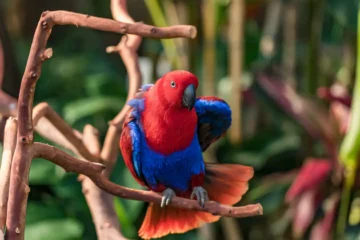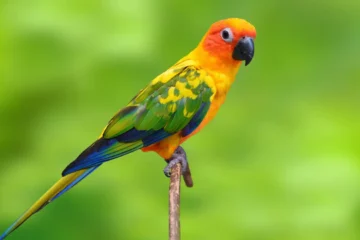The Flame Bowerbird is a bright orange and yellow bird known for its attractive colors and unique courtship behavior. Males build and decorate bowers which are like small stick structures. This effort is done to attract the females.
Their brilliant feathers and dance moves make them one of the most eye-catching birds in the world. Many birdwatchers learn about them through documentaries and zoos.
Images of Flame Bowerbird
Price of Flame Bowerbird
The Flame Bowerbird isn’t sold legally as a pet due to strict wildlife protection laws. The prices in an illegal trade can range from $2,000 to $10,000, but this is highly discouraged and unlawful.

General Characteristics of Flame Bowerbird
This bird possess some unique characteristics different from normal bird species which attract the people towards itself. Here is an overview of some general characteristics of this bird:
| General Characteristic | Flame Bowerbird’s Feature |
| Scientific Name | Sericulus Ardens |
| Size | Grows up to 10.6 inches long |
| Color (Male) | Bright orange with flame-red crown |
| Color (Female) | Olive-brown with faint yellow streaks on chest |
| Diet | Eats fruits, insects, and small invertebrates |
| Vocalization | Makes harsh calls and whistling sounds |
| Behavior | Solitary but except during mating season |

Life Span of Flame Bowerbird
The Flame Blowbird lives around 8 to 10 years when left in the wild. The age can reach up to 15 years when kept in captivity with proper care.

Interesting Facts Related to Flame Bowerbird
This bird is well-known for its behaviour which grabs the attention of the people visiting to see it. Here is a list of certain interesting facts related to this Flame Bowerbird:
1. Fire-Colored Feathers Act as Visual Signals
The male Flame Bowerbird has feathers that shine in fiery shades of red, orange, and yellow. These aren’t just pretty but they’re a visual tool for grabbing attention. The colors seem to glow like a flame when light hits their back.
This reflective trick helps them to be recognized in dense forest. No native bird matches this color display in the USA.
2. Build Artistic Bowers
The male Flame Bowerbird builds bowers, which are structures made only for attracting mates. These bowers are carefully arranged with sticks and decorated with colorful items.
They don’t use the bower for nesting or shelter. It’s all about impressing females for them to come for mating.

3. Color Matching Skills are Admireable
The Flame Bowerbird arranges objects by color near his bower. He often picks fruits, berries, and even flower petals that match the color of his feathers.
This color coordination shows off his visual intelligence. This is not random, instead its selective.
4. Mating Displays Involve Sharp Movements
The male performs sudden, jerky movements that look mechanical during mating. He hops, twists, and freezes in precise patterns. These odd moves contrast with his soft and flowing feathers.
This attractive display appears almost like a dance performance. The birdwatchers compare it to a choreographed stage act.
5. Native to Rainforests of Papua New Guinea
The Flame Bowerbird fascinates American birdwatchers because of its limited habitat. It lives only in tropical rainforests of Papua New Guinea. That makes it a rare sight even for global travelers and it’s habitat isolation adds to its mystery.

6. Young Males Take Years to Grow Flame Colors
Immature males look nothing like adults. They start out with dull green and brown feathers. The brilliant red and orange shades appear only after several years. This slow transformation helps them avoid adult aggression.
7. Females Choose Partners Based on Bower Presentation
The female doesn’t pick mates randomly, rather she inspects each bower closely. She looks for symmetry, object placement, and even the male’s dance skills.
If the setup isn’t perfect then she moves on. It’s a high-stakes selection process and very few birds judge mates this way.
8. Males Compete Without Fighting
Flame Bowerbirds avoid physical fights. They compete artistically instead of using claws or beaks. Each male tries to outshine the other with better bowers and dances.
It’s a peaceful form of rivalry. This non-aggressive strategy stands out among many competitive bird species.
9. Collect Human Trash for Decoration
Flame Bowerbirds use plastic, wrappers, and bottle caps in their displays in areas near villages. They’re opportunistic and creative. This use of human objects shows adaptability.
American crows are known for this, but not for courtship. The bowerbird uses it to win hearts of the females.

10. Bower Take Weeks to Complete
Males may spend days or even weeks perfecting their bower. They rework the design, replace objects, and clean the area. It’s a slow process requiring patience. The goal is to create the most eye-catching stage possible.
11. Courtship Is a Solo Project
Flame Bowerbird males handle everything alone without any teamwork or partners. They build, decorate, and perform without help. The female takes over all nesting and parenting duties after mating.
This solo system contrasts with many bird species where both parents share tasks.
12. Prefer Open Forest Floors for Displays
The Flame Bowerbird doesn’t build in trees. He selects flat and open spots on the forest floor. These spaces allow better visibility for his display because it’s all about getting noticed.
13. Males Sometimes Sabotage Rival Bowers
Some males sneak into another male’s area and destroy his bower to increase their chances. They might steal objects or knock down sticks. It’s a sneaky tactic but common in this species.

14. They Mimic Sounds During Displays
Some Flame Bowerbirds mimic other bird calls or natural forest sounds. These vocal tricks add layers to their performance. It’s not just about looks but also about the sound design.
15. Change Display Style Based on Audience
The male shifts his posture, slows his dance, or changes object placement when a female approaches. He adapts in real-time based on her reactions.
This responsive behavior is a rare social skill among birds. It shows awareness and not just the instinct.
Sightseeing of Flame Bowerbird
This bird prefers to reside in the lowland forests and are mostly visible to public in zoo. Here are some places at which this bird can be seen:
| Location | State in Which it is Located |
| San Diego Zoo | California |
| Bronx Zoo | New York |
| Cincinnati Zoo & Botanical Garden | Ohio |
| Dallas World Aquarium | Texas |
| Smithsonian National Zoo | Washington, D.C. |

How to Take Good Clicks of Flame Bowerbird
Here are certain practical tips to have good clicks of this pretty bird:

-
Use a long lens to capture the bird’s bright colors from a safe distance without disturbing it.
-
Shoot during early morning for softer light and more active behavior from the bird.
-
Focus manually if the bird is moving fast or hiding in branches to keep the image sharp.
-
Wear neutral colors and stay low to blend into the forest while waiting quietly.
-
Use burst mode to increase your chances of catching its display or flight in action.
Final Remarks
Flame Bowerbird is a very rarely seen bird specie with an adorable appearence and unique behavior. The efforts males put to find a proper female mate is something which is rarely seen in birds. These species can be quite fascinating to observe and capture moments with.
FAQs
1. Where can I see a Flame Bowerbird in the USA?
You can’t find Flame Bowerbirds in the wild in the USA; they live in New Guinea’s rainforests.
2. Why is the Flame Bowerbird so brightly colored?
Male Flame Bowerbirds use their bright orange-red feathers to attract females during mating season.
3. Is the Flame Bowerbird kept in zoos in the United States?
Flame Bowerbirds are rare in U.S. zoos and are usually not part of public exhibits due to habitat needs.
4. What does a Flame Bowerbird eat?
It eats fruits, insects, and small invertebrates found in the rainforest.







